
Copyright
The Minerals of Monte Bianco
By Marco Macchieraldo
The Monte Bianco region is a rugged massif in the western Alps situated on the borders of three countries, France (Savoie department), Italy (regione Valle d'Aosta) and Switzerland (Canton Vallese) (Figure 1). To the French, it is known as Mont Blanc. The region is also the highest in the Alps and in western Europe. The geographic limits of the massif are the deep Chamonix valley to the north-west in France, the two valleys near Courmayeur to the south-east in Italy (Val Ferret and Val Veny), and in the north-east it enters the Swiss region of Martigny. The French and Swiss parts of the massif are located within the hydrographic (drainage) basin of the Rhone river, while the Italian side is part of the Po River hydrographic basin.
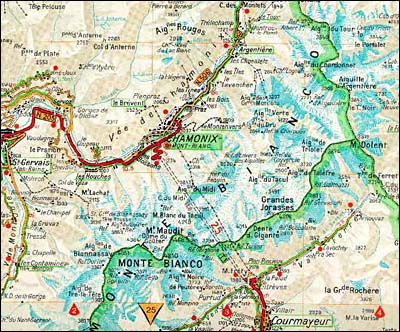
Figure 1: Map of the Monte Bianco massif region.
|
The massif consists of numerous impressive peaks (Figure 2), several exceeding 4000 metres in elevation. From south-west to north-east these peaks include: Dome di Gouter (4306 m), Monte Bianco (4810 m), Mont Maudit (4468 m), Mont Blanc du Tacul (4248 m), Dente del Gigante (4014 m), Grand Jorasses (4206 m), and others. Many important glaciers reside on the French side (Mer de Glace, Glacier du Geant, Glacier des Bossons, Glacier du Talefre', Glacier de Leschaux, Glacier d'Argentiere, Glacier du Tour), but also on the Italian side (Glacier de Miage, Glacier de Brenva, Glacier de Brouillard, Glacier d'Estellette, Glacier de Triolet, and Glacier de Pre de Bar).
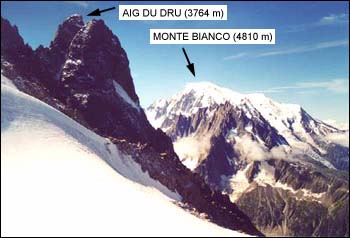
(A)

(B)
Figure 2: Majestic views of the Monte Bianco massif. (A) View toward the 4810 m Monte Bianco (Mont Blanc). (B) View of the Glacier d'Argentiere and surrounding peaks. Fine Gwindel quartz and sceptre quartz specimens are found in this area.
|
Because of the high elevation and rugged terrain, it is not surprising to see why most of this region is very difficult to reach. Today, only 18% of this area has been systematically explored. What remains is virgin territory for mineralogical exploration within the heart of Europe. Furthermore, consider that this is a region subject to very strong erosion. Each winter avalanches, landslides and the expansion and contraction resulting from the heat and cold breaks apart rock exposing fresh new surfaces throughout the massif. The collecting season is restricted to two or three months of the year, and for many years it is not possible to collect because of bad weather.
The massif is not a place for a casual Sunday mineral collecting venture. Only well prepared individuals with appropriate alpine knowledge and experience are able to access and explore this area. These persons are called "cristalliers". They really do risk their life being attached to the rock walls to find the beautiful minerals of Monte Bianco. No price can pay for the risks they take to find these specimens.
| |

Figure 3: The Miage Mine, located at an elevation 3500 meters. It has been closed since the 19th century. While in operation, it was mined 3 to 4 months of the year because of the inhospitable climate. The miners slept in the mine rather than in the huts provided because of the many avalanches. In this old black and white photograph of the mine, it's possible to see the two entries to the mine galleries.
|
However, it is possible to find good specimens at the lowest elevations, mainly in the moraine areas beneath the glaciers. During winter, the forces of erosion cause rocks from the upper elevations to fall onto the surface of the glaciers, and become engulfed by them. After many years retreating glaciers expose the rocks on the moraine. If the rock is crystalized, you will find some crystals.
As general rule, the south-west part of the massif is the richest, producing many different and rare minerals. The north-east part is less rich, but here the crystals are really spectacular. The best specimens of smoky quartz and pink fluorites come from here.
There's only one small old mine on the Italian side called the 'Mine of Miage' that has produced silver galena (Figure 3). The mine is located at an elevation of 3500 metres. It is of course closed and has been since the nineteenth century. In those days the mining season was only three or four months of the year. It is interesting to note that the few miners who worked there preferred to sleep in the galleries, because the huts were constantly under danger by avalanches.
Geology
About 300 million of years ago, during the Ercynic Orogeny, a large granitic intrusion formed the structural base of the actual Monte Bianco region. Millions of years later (a process that started approximately 70 million of years ago, and continues to this day), the Alpine Orogeny lifted this old granitic intrusion and many cracks and fissures were formed in the mass of the rock. Sometime during the uplift hydrothermal fluids penetrated these fissures. From these fluids, beautiful crystals began to grow.
Wonderful specimens of quartz have been found in the fissures of the Monte Bianco massif. The formation of quartz crystals in the fissures is only partially understood, however. Radiometric isotope dating methods applied to Adularia (a variety of Orthoclase that occurs contemporaneously with quartz) indicates that these crystals grew some 18.5 million years ago. The thermodynamic conditions of their growth have been determined from the fluid inclusions in the crystals. The quartz crystals were formed at a depth of about 16 km and at a temperature close to 400°C. As the alps were uplifted, the underlying granite stretched producing fissures and spaces. The rapid injection of super-heated water into these fissures resulted in the formation of quartz crystals. The colour of the quartz crystals is the result of the combined actions of impurities and natural radioactivity in the granite.
The paragenesis of these fissures is relatively simply. Essentially, one can observe the following succession: epidote, quartz, adularia, fluorite, chlorite, calcite, with a series of other less frequently occurring minerals (hematite, galena, etc.).
How fast did the quartz grow? Some studies have suggested that the grow was relatively fast, from several months to years. Later as the chemical equilibrium changed, crystal growth terminated. Crystallization of quartz requires a fluid pressure of 380 MPa (Megapascals). This is almost the same pressure as that exerted by the surrounding rock at a depth of 16 km. And since it is known that the quartz crystals are approximately 18.5 million years old, we are able to calculate for the massif a medium uplift rate of 0.9 mm per year.
Quartz and Fluorite are the sovereign minerals of Monte Bianco. The massif has produced specimens of exceptional quality, highly prized by collectors around the world. There are, of course, many other minerals that occur at Monte Bianco and surrounding regions.
Quartz
As general rule, quartz crystals from Monte Bianco are stocky and of medium size ranging from 3 to 10 cm (Figure 4). The largest one ever found was 40 cm long. They have a macromosaic structure, which means they are the result of sub-parallel growth of multiple crystals. Inside the fissures they are usually found detached from the granite matrix as a consequence of tectonic movements that occurred after their growth. In some cases the crystals exhibit recrystalization, which is one of the reasons for the particular beauty of these specimens.
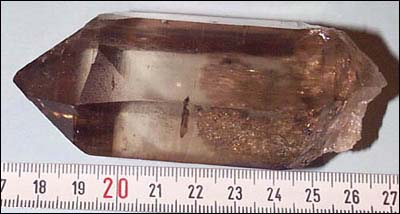
Figure 4: Smoky quartz from the Triolet Glacier, Monte Bianco, Val d'Aosta, Italy. Size 9 x 4 x 4 cm. This is a big single bi-terminated left crystal with exceptional transparency and beautiful ghosts inside.
|
It's very easy to collect the quartz when you have found one of these fissures. You can collect them using your hands and a small pry-bar. But the problem is that the rock surrounding these fissures is always very fractured. At such high elevations (3000 to 4500 m), and in addition to the steep slope of these mountains (which ranges from 60 to 95%), it is very difficult and dangerous to find and extract specimens from one of these fissures. Several cristalliers have died from falling rock or avalanches while attempting to find specimens.
Different crystal habits of quartz have been observed at Monte Bianco. For typical quartz specimens, one can distinguish between the normal left or right crystal forms (Figure 5). Crystals exhibiting Dauphiné twinning are relatively common, whereas Brazil twinning is rare. Japan law twinning has never been observed.
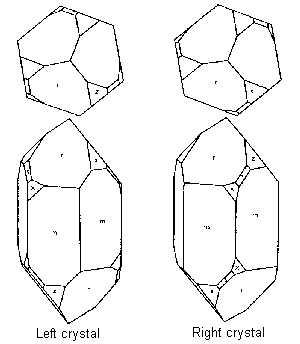
Figure 5: Monte Bianco quartz exhibits the usual right or left crystal forms. This diagram shows the right and left crystallization habits.
|
Gwindel quartz, a very rare crystal form, is known to occur at Monte Bianco (Figures 6 and 7). It is named 'peigne' in France, 'Gwindel' in Switzerland and 'elicoidali' in Italy. This type is the result of parallel growth on a matrix of bi-terminated crystals, but the main axis of the crystals are rotated and exhibit helicoidal growth. It seems that this particular form is caused by piezoelectricity during the crystal growth. Figure 8 below illustrates the growth of a Gwindel quartz, from the closed form to the open form. The specimens shown are not large and the torsion angle ranges from few degrees to an exceptional specimen with a torsion angle of 66 degrees that was found on the Aiguille Croulante around the Argentiere glacier in the north-eastern part of the massif.
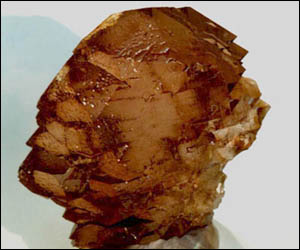
Figure 6: Gwindel smoky quartz, from Aig. de Leschaux (west side), Monte Bianco, France. Size 11 x 10 x 5 cm. This typical smoky Gwindel right quartz is perfectly transparent and has a torsion angle of 35 degrees.

Figure 7: Gwindel smoky quartz from Pointe Isabelle (west side), Monte Bianco, France. Size 5 x 4 x 2 cm. Another typical smoky Gwindel right quartz in the closed shape at the beginning of growth. It is perfectly transparent.
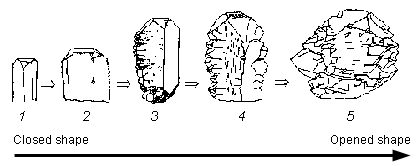
Figure 8: Illustration of the growth of a Gwindel quartz from the closed to the open form.
|
Another interesting habit found is sceptre quartz (Figure 9). Sceptres are very rare, more so than Gwindels. They're located around the Argentiere glacier. Most have a violet colour (amethyst). They are the result of re-crystallization that has occurred on the tips of normal crystals in the presence of tardier fluids rich in copper salts.

Figure 9: Quartz var. amethyst, from Aig. de Triolet (west side), Monte Bianco, France. Size 11 x 8 x 5 cm. Incredible groups of violet-coloured sceptre crystals on white quartz.
|
Also interesting is Faden quartz, which is named "a amé" by the cristalliers (Figure 10). They're relatively common and are the result of the parallel plate growth of bi-terminated crystals without torsion angles. They're similar to the Gwindel crystals, but always show ghosts of growth within them.
| |

Figure 10: Diagram of a Faden crystal. The Fadens are similar to the Gwindels, but they have no torsion angle and they always exhibit ghosts, or phantoms of earlier crystallization inside the crystal.
|
Colours of quartz range from colourless to black, with intermediate to more or less dark smoky colours (smoky quartz). But even the darkest ones are always transparent. The brightness of these quartz specimens is really exceptional and I consider them the best in the world. A lot of quartz specimens have a light coat of green chlorite on the crystals and this creates a beautiful contrast with the smoky colour (Figure 11).
It should be noted here that the smoky quartz specimens from Monte Bianco are not irradiated by artificial means. The smoky colour occurred subsequent to their growth and is the result of two things: structural impurities present within the mineral that create potential colour centres and natural radioactivity. The structural impurities are the result of the substitution of silicon atoms with an electron valence of 4 with one Aluminium atom with a valence 3, and one hydrogen or lithium atom with a valence of 1. These potential colour centres were activated through irradiation by X-rays or gamma rays. This natural radiation derives from the relatively high grade of uranium (about 0.1-0.25 gram per kg) and thorium (0.25-0.4 gram per kg) present in the granite matrix.
It is also interesting to note that quartz crystals become darker with increasing elevation. Below 2400 m quartz crystals are colourless, above 2400 m they are smoky, and at 4000 m they are black (Morion quartz) (Figure 12). There's an interesting scientific theory about this fact. It has been experimentally demonstrated that the colour centres are activated only at temperatures below 225°C.

Figure 11: Quartz with chlorite, from Le Contamines in the southern part of Monte Bianco, France. Size 17 x 11 x 6 cm. Group of colourless crystals, up to 70 mm. It is heavily encrusted with dark green chlorite. The specimen is from a find made in 2001 in the south part of the massif.
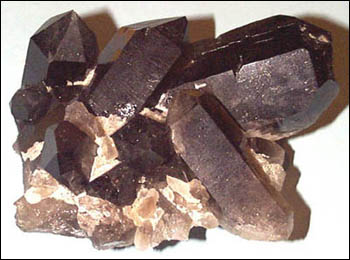
Figure 12: Black quartz (Morion), from Aig. Verte (north side), Monte Bianco, France. Size 11 x 9 x 5 cm. This is an incredible group of beautiful black crystals. Maximum crystal size is 95 mm.
|
During uplift, the rocks in the uppermost part of the massif began to cool first. The rocks deeper below remained took much longer to cool because they remained at greater depths for a longer period of time. The black Morion quartz, which occurs at 4000 m were irradiated at temperatures below 225°C for about two million years – which is longer than for the colourless quartz collected at 2000 m.
Since the Alps are still rising, you could make a Morion quartz by putting a colourless quartz specimen in a fissure at 2000 m at Monte Bianco. Come back in two million years and you will be able to collect a Morion quartz 2000 metres higher – assuming, of course, you are still live then and that other cristalliers have not yet collected the specimen for themselves!
Fluorite
The fluorites from the Monte Bianco massif are among the jewels of the alpine minerals, especially the pink fluorites (Figure 13), which are greatly sought after. Pink fluorites are rare and found as octahedral crystals in groups or clusters on smoky quartz or Morion quartz, or directly on the granite matrix. Other shapes are very uncommon. Deposits of pink fluorite in general are rare and have been found in pegmatites in Pakistan and Poland, and in the metalliferous deposits of Huanzala in Peru. This type of fluorite is characteristically found in alpine fissures at Monte Bianco and fine groupings of octahedral pink fluorite on smoky quartz are particularly beautiful. Specimens recovered during the past three decades have excellent aesthetic appeal and are now considered to rank among the world's most attractive groupings, surpassing even some of the fine Swiss Göschenen specimens, which previously claimed that honour.

Figure 13: Pink fluorite, from Aig. du Chardonnet, Monte Bianco, France. Size 11 x 7 x 5 cm. This specimen consists of a group of exceptional pink octahedral crystals up to 16 mm in size on a granite matrix.
|
The pink fluorites are stained, and the crystal faces are commonly eroded with rounded edges. The eroded faces are due to the action of ice. Crystal size may range from a few millimetres to exceptional 20 cm octahedral crystals. A specimen of the latter size was found by George Bettembourg in 1982 and is believed to be the largest ever found. It is now in the mineralogical museum at Chamonix. The most recent important find of pink fluorites was made by Danielle Lagarde in 1997 on the Tour Noir in the Argentiere glacier. The colour of these fluorites were usually pink or strawberry red (the red colour is caused by inclusions of yttrium inside the crystals) (Figures 14, 15, and 16). They also found some very rare light green crystals and also green crystals with a pink core (Figure 17).
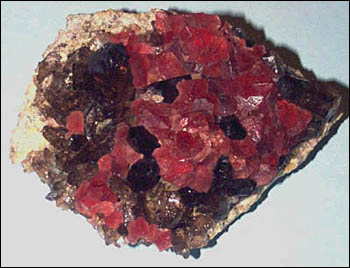
Figure 14: Red fluorite on smoky quartz, from the Glacier d'Argentiere, Monte Bianco, France. Size 14 x 12 x 6 cm. A group of exceptional red octahedral crystals up to 25 mm in size on smoky quartz crystals.

Figure 15: Red fluorite, from M. Mallet, Monte Bianco, France. Size 6 x 5 x 3 cm. A group of perfect red octahedral crystals up to 30 mm in size on a calcite matrix.
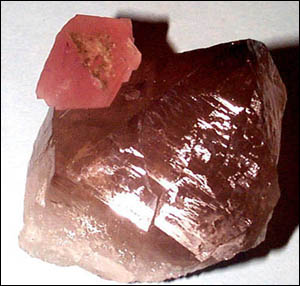
Figure 16: Red fluorite, from Glacier d'Argentiere, Monte Bianco, France. Size 5 x 5 x 3 cm. This interesting specimen consists of a single red octahedral fluorite crystal 20 mm in size on a smoky quartz crystal.

Figure 17: Green fluorite on black quartz, from Glacier du Talefrè, Monte Bianco, France. Specimen size 20 x 12 x 8 cm. An exceptional and wonderful specimen with a big perfect octahedral green crystal 40 mm in size attached to black quartz crystals. (Specimen from the Collection of the Mineralogical Group of Chamonix).
|
Another curiosity is that the most beautiful specimens of fluorite have the same name as the person who discovered them. So we have a specimen named 'Amedee' (a plate of granite 25 cm in diameter with a perfect Morion quartz at the center and many octahedral crystals of red fluorites 4-5 cm in size contouring the quartz), another specimen named 'Georges' (a large octahedral crystal 18 cm in size), and so on.
Other Minerals
Quartz and fluorite are indeed the sovereign minerals of Monte Bianco, but there are many other minerals you can find there as well. However, they are not as exceptional as the quartz and fluorite specimens found. Table 1 gives a list of some of the more common minerals found at Monte Bianco. For more information on these minerals, visit my website, Marco Macchieraldo's Minerals, at web.tiscalinet.it/mmacchieraldo. The website includes photographs of these minerals as well.
Table 1: Minerals other than quartz and fluorite found
at Monte Bianco.
| Mineral Species
|
Adularia
Aeschynite-Ce
Albite
Anatase
Ankerite
Apatite
Aragonite
Axinite
Azurite
Barite
Beryl
Byssolite
Brookite
Calcite
Chabazite
Chalcopyrite
|
Chlorite
Chrysocolla
Dolomite
Epidote
Galena
Goethite
Graphite
Gypsum
Hematite
Hornblende
Kainosite
Laumontite
Magnetite
Malachite
Millerite
Molybdenite
|
Muscovite
Native gold
Prehnite
Pyrite
Rutile
Scheelite
Schorl
Scolecite
Siderite
Sphalerite
Stilbite
Talc
Titanite
Zircon
|
| |
Acknowledgements
Special thanks for this article goes to A.C., a cristallier of Chamonix, Savoie Department, France. In the summer of 2001 he helped me find nice specimens and gave much knowledge about climbing Monte Bianco, locating, and collecting fissure specimens. Without his help this article would not have been possible. I also thank D.D., of the U.S.A. and for helping me with the English translation. Neither wish to be mentioned out of modesty, so only initials are used. I am especially grateful to Dirk Schmid of Canada, who helped fine tune the English translation and edit the article for the Canadian Rockhound.
Explore from Here
 Top of Page
Top of Page

Copyright © 2002 Marco Macchieraldo
E-mail: macchieraldo@tiscalinet.it
Website: http://web.tiscalinet.it/mmacchieraldo
This article may not be copied, distributed or reprinted in any form without the authors' permission. To contact the author, please use the e-mail address provided. If you are unable to contact the author, please contact the Canadian Rockhound. Authorized reprints must acknowledge the author and the Canadian Rockhound, and include the website URL address of the Canadian Rockhound.
All photos were taken by the author and specimens from his personal collection, unless otherwise noted. Photos and illustrations were resized by the Canadian Rockhound to fit this web page.
 More on Copyright
More on Copyright
Article Number: CR0206102
Macchieraldo, M. 2002. The minerals of Monte Bianco. Canadian Rockhound. 6(1):2 [http://www.canadianrockhound.com]







